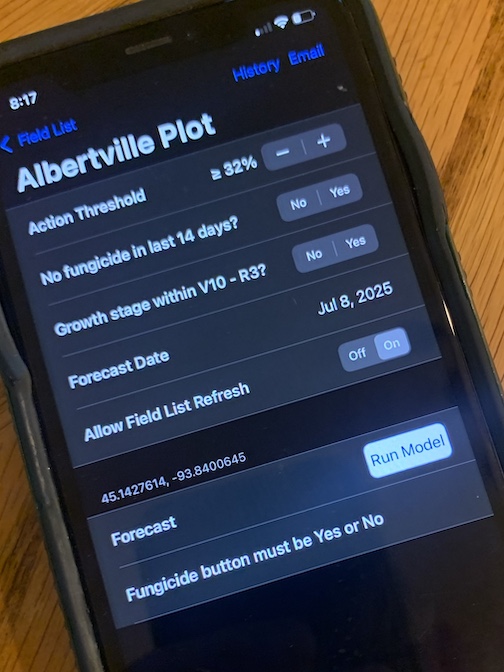Tarspotter Helps Determine Tar Spot Potential
Jul 09, 2025

Now, right after the 4th of July, is the time to scout for tar spot. Originally thought to be a tropical disease, tar spot disease has been moving north for several years and arrived in Federated’s service areas in the past year or two.
A new – free – app called Tarspotter provides an easy way to identify areas and entire fields where tar spot is most likely to occur. The app was developed through the Nutrient and Pest Management (NPM) program at UW–Madison; it was first released to the public in 2023.
Once you enter a field’s name and location (e.g., drop a pin) into the app, Tarspotter uses weather data, along with your answers to a series of questions, to create a statistical model of your crop. With that model, the app can forecast the likelihood of tar spot development.
“Once tar spot is known to be in the area, or you if have a history of tar spot, this app can help determine whether the conditions are right,” said Carlson. Tar spot requires a convergence of three factors: the presence of the pathogen, the right weather conditions, and a host (your crop). With those factors in place, tar spot can adversely affect yields.
Tarspotter will help you determine if weather conditions are favorable for the development of tar spot in your specific area. Generally speaking, “the weather conditions for tar spot are right this year,” said Carlson, adding that “Tarspotter is a tool to use to see if you need to be concerned about tar spot.” The pathogen is wind disseminated, and it resides in crop reside.
Tarspotter is free for both Apple and Android devices and is available in your favorite online app store.
Additional note: No thanks to the southwest flow of winds, another concern this year is southern rust. “It is blown in on an annual basis,” said Carlson, and the storms this year brought it in. Southern rust is one more reason to scout fields often!
For any of these disease concerns, an effective fungicide application between tassel and brown silk (R1-R3) can help mitigate the disease damage. Talk to your Federated Agronomist soon.
A new – free – app called Tarspotter provides an easy way to identify areas and entire fields where tar spot is most likely to occur. The app was developed through the Nutrient and Pest Management (NPM) program at UW–Madison; it was first released to the public in 2023.
Once you enter a field’s name and location (e.g., drop a pin) into the app, Tarspotter uses weather data, along with your answers to a series of questions, to create a statistical model of your crop. With that model, the app can forecast the likelihood of tar spot development.
“Once tar spot is known to be in the area, or you if have a history of tar spot, this app can help determine whether the conditions are right,” said Carlson. Tar spot requires a convergence of three factors: the presence of the pathogen, the right weather conditions, and a host (your crop). With those factors in place, tar spot can adversely affect yields.
Tarspotter will help you determine if weather conditions are favorable for the development of tar spot in your specific area. Generally speaking, “the weather conditions for tar spot are right this year,” said Carlson, adding that “Tarspotter is a tool to use to see if you need to be concerned about tar spot.” The pathogen is wind disseminated, and it resides in crop reside.
Tarspotter is free for both Apple and Android devices and is available in your favorite online app store.
Additional note: No thanks to the southwest flow of winds, another concern this year is southern rust. “It is blown in on an annual basis,” said Carlson, and the storms this year brought it in. Southern rust is one more reason to scout fields often!
For any of these disease concerns, an effective fungicide application between tassel and brown silk (R1-R3) can help mitigate the disease damage. Talk to your Federated Agronomist soon.